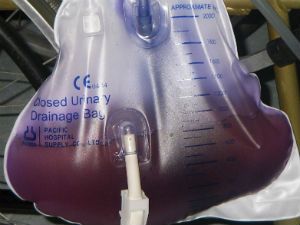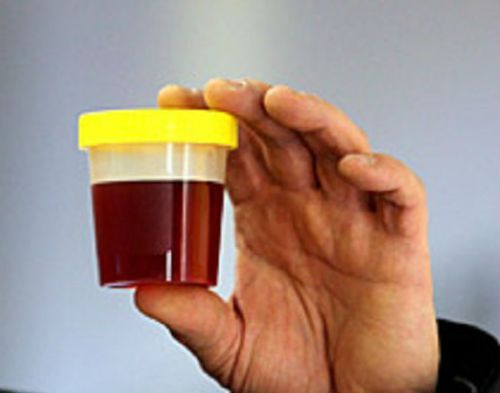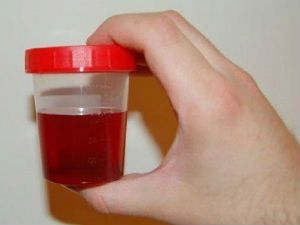The physicians of past centuries were not available modern methods of diagnosing diseases. The main method of the study of urine was the organoleptic method – the study of smell, appearance and taste of this biological fluid.
Currently in medical facilities with special equipment, you can perform any analysis, but each person can assess the external characteristics of his urine. The most important indicator of the development of various pathological conditions is the color of urine. Normally it ranges from light yellow to deep straw hue.
The change in colors indicates serious problems in the body. Everyone knows what a common phenomenon as the allocation of reddish or dark urine indicates disease of the urinary organs. But that means staining the biological substance in unusual colors – at first glance, is very clear.
In our article we want to talk about this phenomenon as “purple bag syndrome”, why a person can stand out purple urine and what needs to be done in this case.
Change the color of urine
Human urine contains urochrome – derived bile pigments, formed during decomposition of hemoglobin.

To the normal hue of urine is influenced by the following factors:
- the volume of the consumed liquid;
- climatic conditions;
- the intensity of metabolic processes;
- diet;
- physical activity.
The contents of urochrome in urine may increase due to high temperatures or prolonged fasting. With abundant excretion of urine shade is very bright, and the shortage of body fluids biological fluid is more concentrated, its color becomes a deep yellow.

When exposed to sunlight urochrome darken and thereby give the urine a brown tinge
The color of urine can change contained in her the lees of salt.
Excessive concentration affects the tint and transparency of biological substances:
- excess urate (uric acid salts), gives the urine an orange tone;
- oxalates (oxalic acid crystals) – whitish;
- phosphates (phosphoric acid salts) – dark yellow.
Such a phenomenon may be a risk of formation of stones, it is therefore necessary to increase fluid intake to two liters a day.
The phenomenon of purple urine may occur when violation of the metabolism of tryptophan and aromatic alpha-amino acids.
To urine probret such an unusual shade, requires the simultaneous action of some factors:
- increased consumption of amino acids contained in leguminous fruits, some varieties of meat, cheese and fish;
- the presence of chronic infectious diseases in the genitourinary tract;
- alkaline urine.
The reasons for staining of a biological liquid in a purple hue, there are many. Let us sequentially consider each of them.
Physiological causes
Most often urine is an unusual color observed in the use of certain medications. Purple urine can be purchased with the use of antibacterial drugs and tools used for instrumental diagnostics.
Complete removal of these drugs from the body provides a dedicated urine the return of usual color.

After a course of antiviral and immunomodulatory drug therapy Tsikloferona can also be painted in purple color. This phenomenon is considered incidental and is described in the annotation to the use of this medication.
With the development of the pathological process nothing to do this phenomenon has. Cycloferon has proven itself an effective means for the treatment and prevention of viral diseases in children.
Food is also able to change the color of urine. If the human metabolism of aromatic amino acids, eating large amounts of food containing these substances, the urine can be painted in unusual colors.
To products which may stain the urine in the color purple include caviar, cheeses, beets, beans, almonds, sunflower seeds, some varieties of bread
If you notice such problems, you must seek the advice of a qualified medical specialist and to eliminate disturbances in the body.
Pathological causes
One of the most famous unnatural causes of purple discoloration of the urine is a serious pathological condition which is called “purple bag syndrome”.
For the first time this phenomenon has been described by practicing biochemists in 1978, the mechanism of its occurrence is the following:
- entering the body with food, tryptophan is converted into serotonin (one of the biogenic amines, referred to as the “happiness hormone”);
- excess serotonin linger in the intestine and by bacteria of the microflora form the indole (condensed connection);
- under the influence of bile acids, the indole is converted to indican (safe product);
- in the final waste determination comes from the liver for the circulating blood to the kidneys;
- in the presence of infections of the urinary tract, bacteria are separated from the indican sulfuric acid and process it into indoxyl;
- in alkaline medium this substance gives to the urine a characteristic blue-violet hue.
Some people are at increased risk of selection of purple urine?
In most cases this phenomenon occurs in frequently ill children, immune compromised patients, the elderly.
At greatest risk are also:
- Women beautiful half of humanity has the features of the anatomical structure of the genitourinary system, contributing to their frequent infection by pathogenic microorganisms.
- Patients who have undergone catheterization of the bladder for a long period, this increases the risk of injury of the body of various pathogenic bacteria.
- People with difficult bowel movements, having alkaline urine (pH over 7.5) and suffer from kidney failure.
Catheterization is one of the factors triggering the pathological state
Changing color of urine can always be a signal of serious violations of the functional activity of internal organs.
Therefore, if you notice any unusual colour of urine you must consult a doctor and pass a comprehensive examination, including laboratory and instrumental methods:
- General clinical and biochemical blood and urine tests;
- bacteriological urine culture and scrapings from the urogenital tract;
- Ultrasound or CT scan of the genitourinary system.
From the foregoing material it becomes clear – to provoke the emergence of the phenomenon of “purple bag” can the presence of urogenital organs, chronic infectious-inflammatory processes, consumption of products with a large number of proteinogenic amino acids (triptophans), the change in the acidity of urine.



